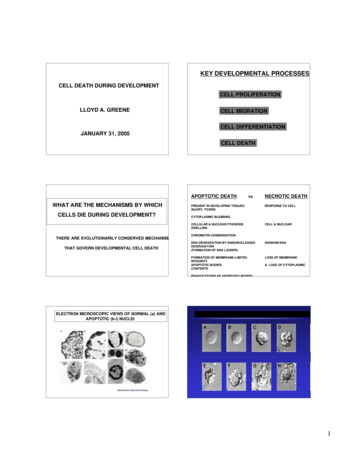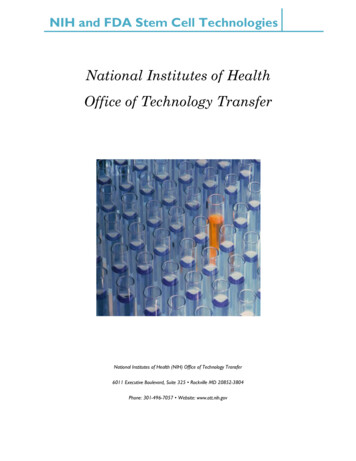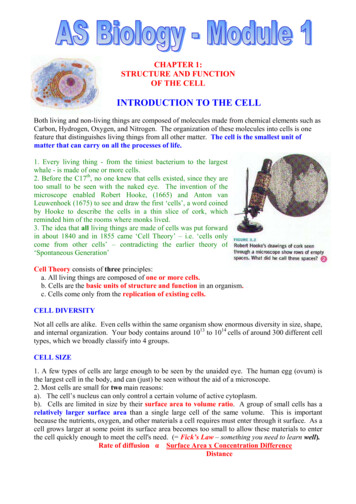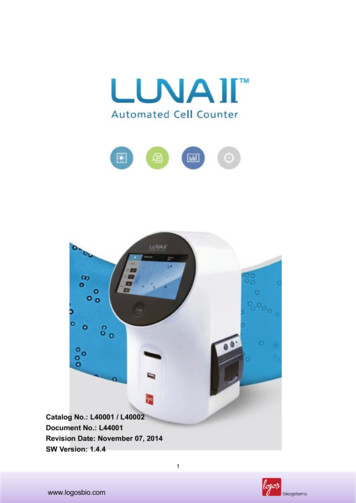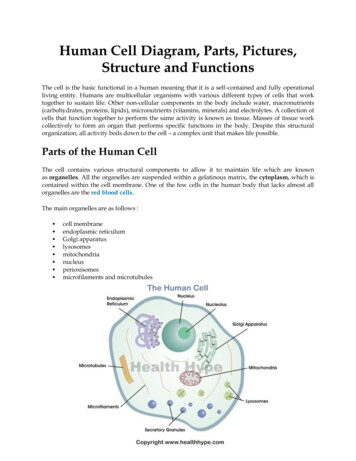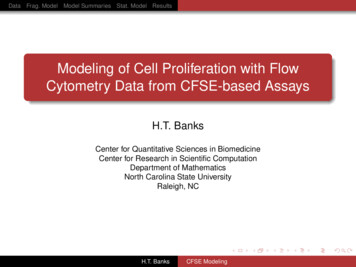
Transcription
Data Frag. Model Model Summaries Stat. Model ResultsModeling of Cell Proliferation with FlowCytometry Data from CFSE-based AssaysH.T. BanksCenter for Quantitative Sciences in BiomedicineCenter for Research in Scientific ComputationDepartment of MathematicsNorth Carolina State UniversityRaleigh, NCH.T. BanksCFSE Modeling
Data Frag. Model Model Summaries Stat. Model ResultsClay Thompson and Karyn SuttonCRSC Postdocs at NCSUTim SchenkelDepartment of Virology, Saarland University, Homburg, GermanyJordi Argilaguet, Sandra Giest,Cristina Peligero, Andreas MeyerhansICREA Infection Biology Lab, Univ. Pompeu Fabra, Barcelona, SpainGennady BocharovInstitute of Numerical Mathematics, RAS, Moscow, RussiaH.T. BanksCFSE Modeling
Data Frag. Model Model Summaries Stat. Model Results1CFSE Data Overview2Initial Fragmentation Model of CFSE Data3Model Summaries4Data Statistical Model5ResultsH.T. BanksCFSE Modeling
Data Frag. Model Model Summaries Stat. Model ResultsSelected Sources and ReferencesH.T. Banks, Frederique Charles, Marie Doumic, Karyn L. Sutton, and W. Clayton Thompson, Labelstructured cell proliferation models, Appl. Math. Letters 23 (2010), 1412–1415;doi:10.1016/j.aml.2010.07.009H.T. Banks, Karyn L. Sutton, W. Clayton Thompson, Gennady Bocharov, Dirk Roose, Tim Schenkel, andAndreas Meyerhans, Estimation of cell proliferation dynamics using CFSE data, CRSC-TR09-17, NorthCarolina State University, August 2009; Bull. Math. Biol., 70 (2011), 116–150.H.T. Banks, Karyn L. Sutton, W. Clayton Thompson, G. Bocharov, Marie Doumic, Tim Schenkel, JordiArgilaguet, Sandra Giest, Cristina Peligero, and Andreas Meyerhans, A new model for the estimation of cellproliferation dynamics using CFSE data, CRSC-TR11-05, North Carolina State University, Revised July2011; J. Immunological Methods, 373 (2011), 143–160; DOI:10.1016/j.jim.2011.08.014.H.T. Banks, W. Clayton Thompson, Jordi Argilaguet, Cristina Peligero, and Andreas Meyerhans, Adivision-dependent compartmental model for computing cell numbers in CFSE-based lymphocyteproliferation assays, CRSC-TR12-03, N. C. State University, Raleigh, NC, January, 2012; Math. Biosci.Engr., to appear.H.T. Banks and W. Clayton Thompson, Mathematical models of dividing cell populations: Application toCFSE data, CRSC-TR12-10, N. C. State University, Raleigh, NC, April, 2012; Journal on MathematicalModelling of Natural Phenomena, to appear.H.T. Banks and W. Clayton Thompson, A division-dependent compartmental model with cyton andintracellular label dynamics, CRSC-TR12-12, N. C. State University, Raleigh, NC, May, 2012; Intl. J. of Pureand Applied Math., 77 (2012), 119–147.H.T. BanksCFSE Modeling
Data Frag. Model Model Summaries Stat. Model ResultsSelected Sources and ReferencesH.T. Banks, Amanda Choi, Tori Huffman, John Nardini, Laura Poag and W. Clayton Thompson, ModelingCFSE label decay in flow cytometry data, CRSC-TR12-20, N. C. State University, Raleigh, NC, November,2012; Applied Mathematical Letters, (2103), doi:10.1016/j.aml.2012.12.010.H.T. Banks, D. F. Kapraun, W. Clayton Thompson, Cristina Peligero, Jordi Argilaguet and AndreasMeyerhans, A novel statistical analysis and interpretation of flow cytometry data, CRSC-TR12-23, N. C.State University, Raleigh, NC, December, 2012; J. Biological Dynamics, submitted.A.V. Gett and P.D. Hodgkin, A cellular calculus for signal integration by T cells, Nature Immunology 1 (2000),239–244.E.D. Hawkins, Mirja Hommel, M.L Turner, Francis Battye, J Markham and P.D Hodgkin, Measuringlymphocyte proliferation, survival and differentiation using CFSE time-series data, Nature Protocols, 2(2007), 2057–2067.E.D. Hawkins, M.L. Turner, M.R. Dowling, C. van Gend, and P.D. Hodgkin, A model of immune regulation asa consequence of randomized lymphocyte division and death times, Proc. Natl. Acad. Sci., 104 (2007),5032–5037.T. Luzyanina, D. Roose, T. Schenkel, M. Sester, S. Ehl, A. Meyerhans, and G. Bocharov, Numericalmodelling of label-structured cell population growth using CFSE distribution data, Theoretical Biology andMedical Modelling 4 (2007), Published Online.C. Parish, Fluorescent dyes for lymphocyte migration and proliferation studies, Immunology and Cell Biol.77 (1999), 499–508.H.T. BanksCFSE Modeling
Data Frag. Model Model Summaries Stat. Model ResultsSelected Sources and ReferencesB. Quah, H. Warren and C. Parish, Monitoring lymphocyte proliferation in vitro and in vivo with theintracellular fluorescent dye carboxyfluorescein diacetate succinimidyl ester, Nature Protocols 2:9 (2007),2049–2056.D. Schittler, J. Hasenauer, and F. Allgöwer, A generalized model for cell proliferation: Integrating divisionnumbers and label dynamics, Proc. Eighth International Workshop on Computational Systems Biology(WCSB 2011), June 2001, Zurich, Switzerland, p. 165–168.J. Hasenauer, D. Schittler and F. Allgöwer, Analysis and simulation of division- and label-structuredpopulation models: A new tool to analyze proliferation assays, Bull. Math. Biol., 74 (2012), 2692–2732.H.T. BanksCFSE Modeling
Data Frag. Model Model Summaries Stat. Model ResultsScientific GoalsLong-term collaboration between NCSU and UPFMonitor cell division and differentiationAssess polyfunctionalityInvestigate immunospecific extracellular signaling pathwaysIdentify correlated and (ideally) causal relationshipsbetween immune mechanismsQuantitative measure of ‘dynamic responsiveness’Link observed (cellular) behaviors to clinical outcomes;improve clinical outcomesThe ‘central problem in immunology’ (according to G.Bocharov): to understand the ‘cellular and molecularmechanisms that control the ability of the immune systemto mount a protective response against pathogen-derivedforeign antigens, but avoid a pathological response toself-antigens’H.T. BanksCFSE Modeling
Data Frag. Model Model Summaries Stat. Model ResultsPersistent InfectionsTrade-off between immune protection and immunopathy canlead to persistent infection(A. Meyerhans)H.T. BanksCFSE Modeling
Data Frag. Model Model Summaries Stat. Model ResultsPersistent Infections (cont’d)(A. Meyerhans)‘Dynamic equilibrium’ between host immune response andmicrobe expansionApplications in HIV, HCV, TBOpen questions:Characterization of set pointOutcome of perturbations, modification for host benefitH.T. BanksCFSE Modeling
Data Frag. Model Model Summaries Stat. Model ResultsGoalsObservations:Clinical outcome believed to be strongly influenced by timing andmagnitude of ‘clonal expansion’CFSE (intracellular dye) flow cytometry powerful new tool fortracking cell divisionAnalysis of data:Develop a mathematical model for CFSE dataLink cell counts to measures of proliferation/death ratesPopulation doubling time; cell cycle timeCell viabilityApplications:Analyze experimental and biological variabilityOptimal experimental designLab experiments (more in a moment.)H.T. BanksCFSE Modeling
Data Frag. Model Model Summaries Stat. Model ResultsCFSE Data SetCFSE Time Series Histogram DataStructured Population Density [numbers/UI]53.5x 10t 0 hrst 24 hrst 48 hrst 72 hrst 96 hrst 120 hrs32.521.510.5000.511.52Label Intensity z [Log UI]H.T. Banks2.5CFSE Modeling33.5
Data Frag. Model Model Summaries Stat. Model ResultsData Overview(A. Meyerhans)H.T. BanksCFSE Modeling
Data Frag. Model Model Summaries Stat. Model ResultsCFSE Labeling (Lyons and Parish, 1994)Cells cultured with CFDA-SE (carboxyfluorescein diacetatesuccinimidyl ester) then washedCFDA-SE becomes protein-bound and fluorescent CFSE(the fluorescent dye carboxyfluorescein succinimidyl ester)Dye split between daughter cells at divisionDye naturally turns over/degrades (very slowly)Fluorescence Intensity (FI) of CFSE measured via flowcytometryFI linear with dye concentration FI massSeveral advantages over other dyes/techniquesH.T. BanksCFSE Modeling
Data Frag. Model Model Summaries Stat. Model ResultsCFSE Labeling (Lyons and Parish, 1994)(C. Parish, Fluorescent dyes for lymphocyte migration and proliferation studies, Immunology and Cell Biol. 77(1999), 499–508.)H.T. BanksCFSE Modeling
Data Frag. Model Model Summaries Stat. Model ResultsCFSE Data SetCFSE Time Series Histogram DataStructured Population Density [numbers/UI]53.5x 10t 0 hrst 24 hrst 48 hrst 72 hrst 96 hrst 120 hrs32.521.510.5000.511.52Label Intensity z [Log UI]H.T. Banks2.5CFSE Modeling33.5
Data Frag. Model Model Summaries Stat. Model ResultsGoals of ModelingCellular ‘Dynamic Responsiveness’Link cell counts with proliferation/death ratesPopulation doubling timeCell viabilityBiological descriptors (cell cycle time, etc.)Uncertainty Quantification. in the experimental procedure. for estimated rates/etcAnalyze cell differentiation and division-linked changesInvestigate immunospecific extracellular signalingpathwaysComparison among donors/cell types/disease progressionH.T. BanksCFSE Modeling
Data Frag. Model Model Summaries Stat. Model ResultsTraditional Approach (Gett and Hodgkin)Traditional ‘semi-quantitative analysis’ pioneered by Gettand Hodgkin et al. (2000)Fit data with gaussian curves to determine approximatecells per generation(A.V. Gett and P.D. Hodgkin, A cellular calculus for signal integration by T cells, Nature Immunology 1 (2000),239–244.)H.T. BanksCFSE Modeling
Data Frag. Model Model Summaries Stat. Model ResultsTraditional Approach (cont’d)Gett-Hodgkin method quick, easy to implement, usefulcomparisons between data sets (e.g. stimulationconditions)Compatible with ODE, DDE models; ‘indirect fitting’ forparameter estimationGeneralizations, extensions, and various other modelingeffortsSmith-Martin model (with generalizations)Cyton modelBranching process modelsH.T. BanksCFSE Modeling
Data Frag. Model Model Summaries Stat. Model ResultsLabel-Structured ModelAll previous work with cell numbers determined bydeconvolutionAlternatively, we propose to fit the CFSE histogram datadirectlyCapture full behavior of the population densityNo assumption on the shape of CFSE uptake/distributionHistogram presentation of cytometry data makesstructured population models a natural choice (as in age,size, etc) except here structure label is “CFSE content orintensity”Key ideas first formulated by Luzyanina, Bocharov, et al.,2007FI (or log FI) Division NumberH.T. BanksCFSE Modeling
Data Frag. Model Model Summaries Stat. Model ResultsLabel-Structured Model (cont’d)This model must account for (Luzyanina et al., 2007):Slow decay of CFSE FI over timeDilution of CFSE as cells divideAsynchronous division timesData in Logarithmic Coordinate (z)53.5x 10t 24 hrst 48 hrst 96 hrst 120 hrs3Cell Counts2.521.510.5000.511.52z [Log UI]H.T. Banks2.5CFSE Modeling33.5
Data Frag. Model Model Summaries Stat. Model ResultsRate of Label Decay(C. Parish, Fluorescent dyes for lymphocyte migration and proliferation studies, Immunology and Cell Biol. 77(1999), 499–508.)H.T. BanksCFSE Modeling
Data Frag. Model Model Summaries Stat. Model Results‘Biphasic Decay’Donor 1 Exponential Fit,45x 104.54CFSE IntensityCFSE Intensityx 104.543.532.53.532.521.50Donor 1 Gompertz Fit,45220dxdt406080Time (hrs)100120140160 v(x) c(x xa )ExponentialH.T. Banks1.50dxdt20406080Time (hrs)100120140160 v(t, x) c(x xa )e ktGompertzCFSE Modeling
Data Frag. Model Model Summaries Stat. Model Results‘Translated Coordinate’ (Banks et al, 2010)While the structure variable z does correlate with divisionnumber, the ‘translated variable’ cs(t, z) z e kt 1k log 10has an even stronger correlation.Follows from the Method of CharacteristicsIntuitively, s represents the FI of a cell with a hypotheticallabel which does not decayChange of reference: Eulerian vs Lagrangian coordinatesH.T. BanksCFSE Modeling
Data Frag. Model Model Summaries Stat. Model Results‘Translated Coordinate’ (cont’d)Data in Logarithmic Coordinate (z)53.5x 10t 24 hrst 48 hrst 96 hrst 120 hrs3Cell Counts2.521.510.5000.513.51.52z [Log UI]2.533.5Data in Translated Coordinate s5x 10t 24 hrst 48 hrst 96 hrst 120 hrsX: 1.592Y: 3.109e 053Cell Counts2.521.510.50 1 0.500.51H.T. Banks1.5s [Log UI]22.53CFSE Modeling3.54
Data Frag. Model Model Summaries Stat. Model ResultsFragmentation Model SummaryModel is capable of precisely fitting the observed datac, k, xa estimated consistently (as α and β nodes change),though subject to high experimental variability‘Translated coordinate’ very strongly correlated withdivision numberTime-dependence of the proliferation rate is an essentialfeature of the modelBiologically relevant average values of proliferation anddeath (in terms of number of divisions undergone) areeasily computable.But.(Aggregate Data/Aggregate Dynamics)Still cannot compute cell numbers and cohort rateparametersData overlap affecting estimated rates (?)Large number of parameters necessaryH.T. BanksCFSE Modeling
Data Frag. Model Model Summaries Stat. Model ResultsBest-fit, AIC-selected results: Model A5B5Distx 10Calibrated Model, t 48hrs4Calibrated Model, t 24hrs4109DataModelx 10DataModel887Cell CountsCell Counts664543221000.51Log UI22.53003.50.5Calibrated Model, t 96hrs52.51.5x 1011.5DataModelLog UI22.533.5Calibrated Model, t 120hrs53.5x 10DataModel32Cell CountsCell Counts2.51.5121.510.50.5000.511.5Log UI22.53H.T. Banks3.5000.51CFSE Modeling1.5Log UI22.533.5
Data Frag. Model Model Summaries Stat. Model ResultsCell NumbersTotal Cell Counts710x 10Number of Precursors8Number of CellsTotal Precursors615UndividedDividedTotal64x 10UndividedDividedTotal105200204060Time [hrs]Ni (t) R80100120ni (t, x)00204060Time [hrs]Pi (t) Ni80(t)/2iPopulation doubling time and precursor viability easilycomputableH.T. BanksCFSE Modeling100120
Data Frag. Model Model Summaries Stat. Model ResultsLabel Structure Fragmentation Model-Model 1CFSE label dynamics can be described by the fragmentationequation n(t, x) [(x xa )n(t, x)] ce kt t x (α(t, x) β(t, x))n(t, x)χ[xa ,x ] 4α(t, 2x xa )n(t, 2x xa )n(0, x) Φ(x)n(t, xmax ) 0v(t, xa )n(t, xa ) 0.(1)where n(t, x) is the structured population density (cells per unitFI) at time t and measured FI x and the advection term (withparameters c and k) represents the Gompertz decay processfor decrease in FI resulting from intracellular turnover of CFSE.H.T. BanksCFSE Modeling
Data Frag. Model Model Summaries Stat. Model ResultsCompart. Models with Generation Structure-Model 2A model can be reformulated with distinct compartments foreach generation. The resulting model is a system of partialdifferential equations n0 n ce kt (x xa ) 0 (α0 (t) β0 (t) ce kt )n0 (t, x) t x n1 n1 kt ce (x xa ) (α1 (t) β1 (t) ce kt )n1 (t, x) t x R1 (t, x). nimax ni ce kt (x xa ) max (βimax (t) ce kt )nimax (t, x) t x Rimax (t, x),(2)H.T. BanksCFSE Modeling
Data Frag. Model Model Summaries Stat. Model ResultsCompartmental Models-Model 2Here ni (t, x) is structured population density for cells havingundergone i divisions. The recruitment terms describe thesymmetric division of CFSE upon mitosis. Given byRi (t, x) 4αi 1 (t)ni 1 (t, 2x xa ). Boundary and initialconditions same as in (1).Observe that, because the number of divisions undergone hasnow been explicitly identified by the subscripted generationnumber, no longer necessary for division and death rates todepend upon measured fluorescence intensity.H.T. BanksCFSE Modeling
Data Frag. Model Model Summaries Stat. Model ResultsCompartmental Models-Model 3IDEA: Combine compartmental models with probabilisticstructures (so-called Cyton Models) for cell division and deathLet Ni (t), 0 i imax represent the number of cells havingundergone i divisions at time t. Assume there are N0 cells inthe population at t 0. In its simplest form, the cyton modelrelates the number of cells in the population to the number ofcells which divide and die in a unit of time,Z t N0 (t) N0 n0div (s) n0die (s) ds0Z t divNi (t) 2ni 1(s) nidiv (s) nidie (s) ds,(3)0where nidiv (t) and nidie (t) indicate the numbers per unit time ofcells having undergone i divisions that divide and die,respectively, at time t.H.T. BanksCFSE Modeling
Data Frag. Model Model Summaries Stat. Model ResultsCompartmental Models-Model 3Let φ0 (t) and ψ0 (t) be probability density rate functions (in units1/time) for the times to division and death, respectively, for anundivided cell. Let F0 , the initial precursor fraction, be thefraction of undivided cells which would hypothetically divide inthe absence of any cell death. It follows that Z tdivn0 (t) F0 N0 1 ψ0 (s)ds φ0 (t)0 Z tdien0 (t) N0 1 F0φ0 (s)ds ψ0 (t).(4)0H.T. BanksCFSE Modeling
Data Frag. Model Model Summaries Stat. Model ResultsCompartmental Models-Model 3Can define probability density rate functions φi (t) and ψi (t) fortimes to division and death, respectively, for cells havingundergone i divisions, as well as the progressor fractions Fi ofcells which would complete the i th division in the absence ofcell death. Then the numbers per unit time of dividing anddying cells are computed as Z tZ t sdivdivni (t) 2Fini 1 (s) 1 ψi (ξ)d ξ φi (t s)ds00 Z tZ t sdiedivni (t) 2ni 1 (s) 1 Fiφi (ξ)d ξ ψi (t s)ds. (5)00H.T. BanksCFSE Modeling
Data Frag. Model Model Summaries Stat. Model ResultsCompartmental Models-Model 4Allgöwer, et al., have proposed a model which is structured bythe fluorescence intensity resulting from the mass of CFSEwithin the cell, i.e., intracellular label ignoring autofluorescence.This leads to a system for the mass of fluorescence n(t, x)described by the system of equations [xn0 ] n0 ce kt (α0 (t) β0 (t))n0 (t, x) t x. ni [xni ] ce kt (αi (t) βi (t))ni (t, x) 4αi 1 (t)ni 1 (t, 2x) t x(6).with boundary and initial conditions as in (1) and (2).H.T. BanksCFSE Modeling
Data Frag. Model Model Summaries Stat. Model ResultsCompartmental Models-Model 4The major advantage of formulating the model in terms of massof FI is the very simple form of the model solution. The solutionto the model (6) can be written asni (t, x) Ni (t)n̄i (t, x)(7)for all i. In this representation the functions Ni (t) satisfy theweakly coupled system of ordinary differential equationsdN0 (α0 (t) β0 (t))N0 (t)dtdN1 (α1 (t) β1 (t))N1 (t) 2αi 1 (t)Ni 1 (t)dt.with initial conditions N0 (0) N0 , Ni (0) 0 for all i 1.H.T. BanksCFSE Modeling(8)
Data Frag. Model Model Summaries Stat. Model ResultsCompartmental Models-Model 4The functions n̄i (t, x) each satisfy the partial differentialequation n̄i (t, x) [x n̄i (t, x)] ce kt 0 t xwith initial conditionn̄i (0, x) 2i Φ(2i x).N0Note that, by definition,N0 Z Φ(ξ)d ξ.0H.T. BanksCFSE Modeling(9)
Data Frag. Model Model Summaries Stat. Model ResultsCompartmental Models-Model 4Let ñi (t, x̃ ) be the structured density relative to the measuredfluorescence (x̃ is related to x by the addition of cellularautofluorescence). To account for autofluorescence andbecause autofluorescence may vary from cell to cell in thepopulation, this is most accurately treated by computing theconvolution integralZ ñ(t, x̃ ) n(t, x)p(t, x̃ x)dx,(10)0where p(t, x̃) is (for each fixed time t) a probability densityfunction describing the distribution of autofluorescence in thepopulation.H.T. BanksCFSE Modeling
Data Frag. Model Model Summaries Stat. Model ResultsCompartmental Models-Model 4So finally we consider the system of equations n0 [xn0 ] div ce kt n0 (t) n0die (t) n̄0 (t, x) t x [xn n11] ce kt 2n0div (t) n1div (t) n1die (t) n̄1 (t, x) t x(11).where the definitions of n0div (t), n0die (t), nidiv (t) and nidie (t) aregiven in Equations (4) - (5).H.T. BanksCFSE Modeling
Data Frag. Model Model Summaries Stat. Model ResultsCompartmental Models-Model 4This model, which is based on simple mass balance, can besolved by factorization (7) as before; the label densities n(t, x)are readily computed according to Equation (9), and the cellnumbers are now provided by the cyton model as discussedabove. Thus the new model (11) is capable of accuratelydescribing the evolving generation structure of a population ofcells while also accounting for the manner in which the CFSEprofile of the population changes in time. The model is easilyrelatable to biologically meaningful parameters (times todivision and death) and can be solved efficiently so that it iseminently suitable for use in an inverse problem.H.T. BanksCFSE Modeling
Data Frag. Model Model Summaries Stat. Model ResultsThe Statistical ModelLinks the mathematical model to the dataImplications for estimation procedure (Least squares vs.weighted least squares)Nkj I[ñ](tj , zkj ; θ0 ) (I[ñ](tj , zkj ; θ0 ))γ EkjEarly efforts using constant variance (CV) model,Var (Ekj ) σ02 ( Absolute Error: Ykj model Ekj )Also tried constant coefficient of variance (CCV),Var (Ekj ) σ02 I[ñ](tj , zkj ; θ0 )2 ( RelativeError:Ykj model (1 Ekj ))Found in between error most closely described data,jVar (Ekj ) σ02 I[ñ](tj , zk ; θ0 ) ( SquareRoot Error: Ykj model model Ekj )H.T. BanksCFSE Modeling
Data Frag. Model Model Summaries Stat. Model ResultsResidual Plots γ 0 vs. γ 1Residuals vs Model46x 10Modified Residuals vs Model104Modified Residuals5Residuals20 20 5 4 600.511.5Model Solution2 1002.50.55x 10H.T. BanksCFSE Modeling11.5Model Solution22.55x 10
Data Frag. Model Model Summaries Stat. Model ResultsResidual PlotsModified (sqrt) Residuals vs ModelResiduals vs Model405000Modified (sqrt) ResidualsResiduals30020100 10 20 30 50000Nkj0.5 11.5Model SolutionI[ñ](tj , zkj ; q0 ) 40020.54x 10(I[ñ](tj , zkj ; q0 ))γ Ekj11.5Model Solution2 with γ 0 (left) vs.γ 1/2 (right). And γ 1/2 works well!!H.T. BanksCFSE Modeling4x 10
Data Frag. Model Model Summaries Stat. Model ResultsLeast Squares EstimationDefineqWLS arg min J(q; {λj })q Q arg minq Q j 2X λj I[n̂](tj , zk ; q) Nkj,kwkjwherejwk λj B I[n̂](tj , zkj ; q0 ), I[n](tj , zkj ; q0 ) I b̂j λj B I ,b̂jjI[n](tj , zk ; q0 ) I .Then qWLS is a consistent estimator of q0 (Banks, Kenz,Thompson, 2012)H.T. BanksCFSE Modeling
Data Frag. Model Model Summaries Stat. Model ResultsFit to DataApproximated Initial Condition, t 23.5 hrs4σ RegionDataModelCounted Cells500040003000200010000012345Log Fluorescence Intensity [log UI]Donor 2, CD4 cells, Day 1, Data Set 121H.T. BanksCFSE Modeling6
Data Frag. Model Model Summaries Stat. Model ResultsFit to Data (cont’d)Fit to Data, t 46 hrs4σ RegionDataModelCounted Cells500040003000200010000012345Log Fluorescence Intensity [log UI]Donor 2, CD4 cells, Day 2, Data Set 121H.T. BanksCFSE Modeling6
Data Frag. Model Model Summaries Stat. Model ResultsFit to Data (cont’d)Fit to Data, t 67.5 hrs4σ RegionDataModelCounted Cells500040003000200010000012345Log Fluorescence Intensity [log UI]Donor 2, CD4 cells, Day 3, Data Set 121H.T. BanksCFSE Modeling6
Data Frag. Model Model Summaries Stat. Model ResultsFit to Data (cont’d)Fit to Data, t 94.5 hrs4σ RegionDataModelCounted Cells500040003000200010000012345Log Fluorescence Intensity [log UI]Donor 2, CD4 cells, Day 4, Data Set 121H.T. BanksCFSE Modeling6
Data Frag. Model Model Summaries Stat. Model ResultsFit to Data (cont’d)Fit to Data, t 117.5 hrs4σ RegionDataModelCounted Cells500040003000200010000012345Log Fluorescence Intensity [log UI]Donor 2, CD4 cells, Day 5, Data Set 121H.T. BanksCFSE Modeling6
Data Frag. Model Model Summaries Stat. Model ResultsFit to Data, CD8 CellsFit to Data, t 94.5 hrsFit to Data, t 94.5 hrsCounted Cells8000600040006000400020002000004σ RegionDataModel8000Counted Cells4σ RegionDataModel1000012345Log Fluorescence Intensity [log UI]60012345Log Fluorescence Intensity [log UI]6Donors 1 (left) and 2 (right), CD8 cells, Day 4, Data Set 121H.T. BanksCFSE Modeling
Data Frag. Model Model Summaries Stat. Model ResultsCytonsTime to Division/DeathTime to Division/Death for Undivided Cells0.4Probability DensityProbability Density0.020.0150.010.00500204060Time [hrs]801001200.20 0.2 0.40204060Time [hrs]80100120Donor 2, CD8 cells, undivided (left) and divided (right), DataSet 121H.T. BanksCFSE Modeling
Data Frag. Model Model Summaries Stat. Model ResultsGeneration StructureCell Numbers5x 10012634546 Number of CellsNumber of Cellsx 10018234656 4102200204060Time [hrs]8010000120Cell Numbers5x 10012344536 2204060Time [hrs]8010012080100120Cell Numbers56x 10012634546 8Number of Cells5Number of CellsCell Numbers582100204060Time [hrs]8010012000204060Time [hrs]Donor 1 (top) and Donor 2 (bottom), CD4 cells (left) and CD8cells (right)H.T. BanksCFSE Modeling
Data Frag. Model Model Summaries Stat. Model ResultsExperimental ExtensionsAccount for multiple cell cultures present in PBMC cultureAntigen-specific stimulationEffects of cryopreservationExtracellular signaling, knockout experimentsIn vitro vs in vivo differencesLinking to immune process modelsAnalyze Proliferation in Diseased vs Healthy cellsH.T. BanksCFSE Modeling
Data Frag. Model Model Summaries Stat. Model ResultsAcknowledgementsNational Institute of Allergy and Infectious Disease grant NIAID9R01AI071915U.S. Air Force Office of Scientific Research under grantAFOSR-FA9550-09-1-0226H.T. BanksCFSE Modeling
Data Frag. Model Model Summaries Stat. Model Results Modeling of Cell Proliferation with Flow Cytometry Data from CFSE-based Assays H.T. Banks . (A.V. Gett and P.D. Hodgkin, A cellular calculus for signal integration by T cells, Nature Immunology 1 (2000), 239-244.) H.T. Banks CFSE Modeling.
